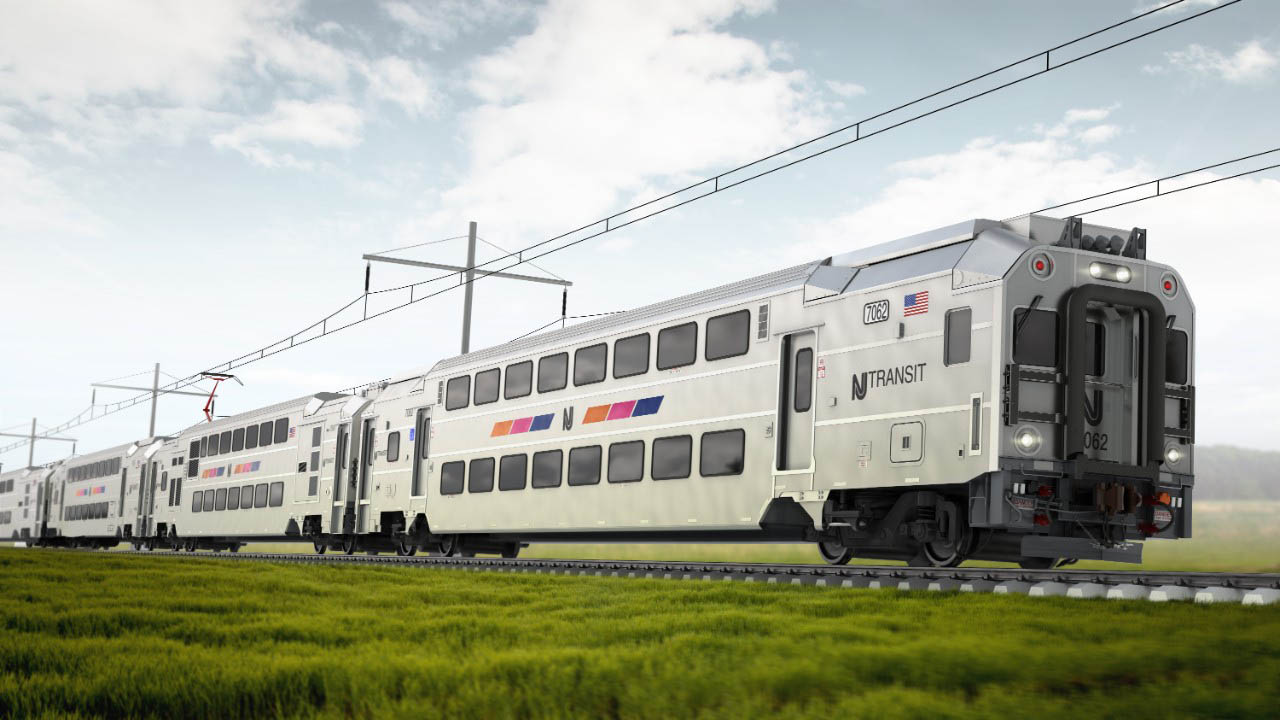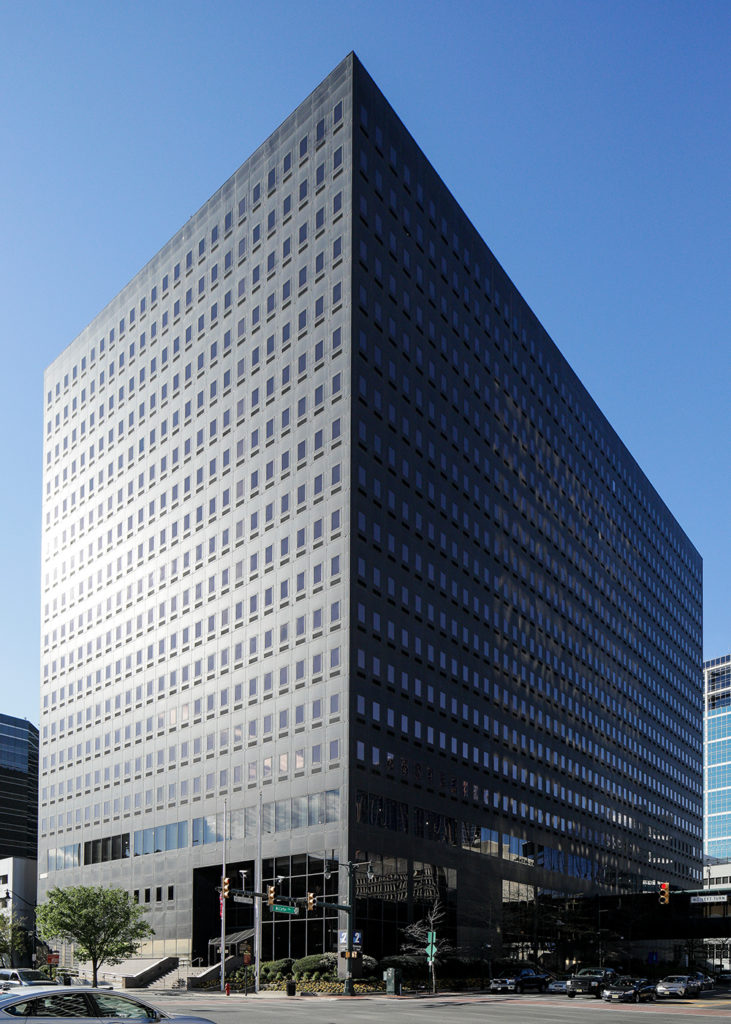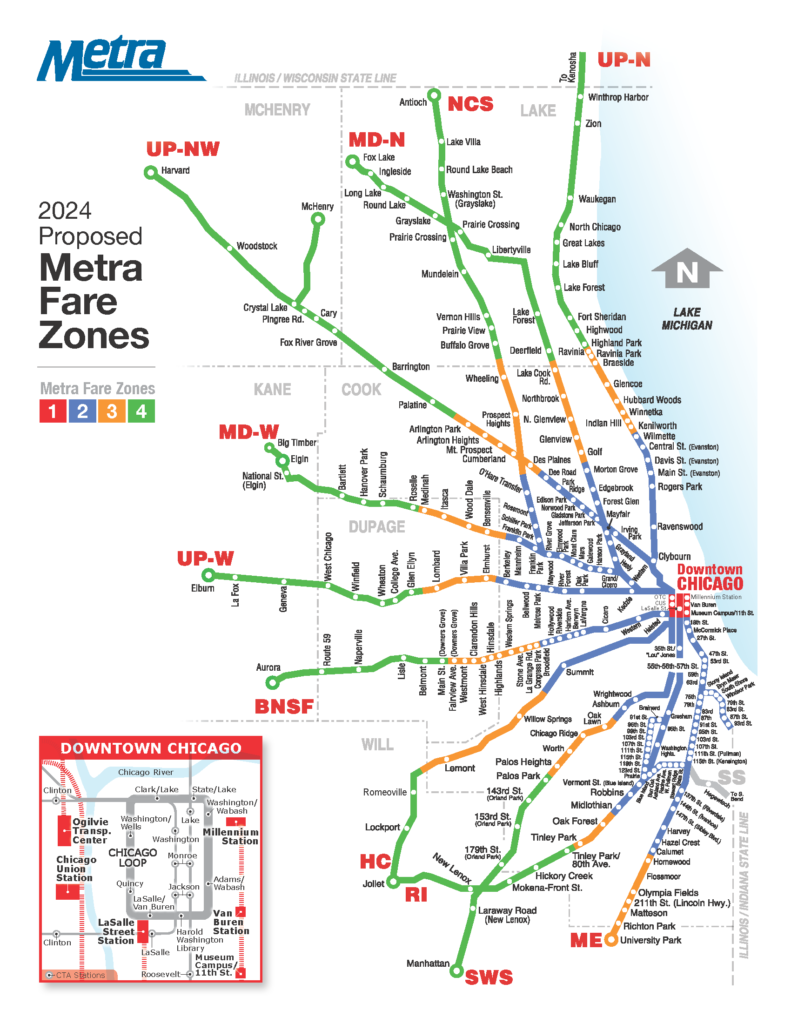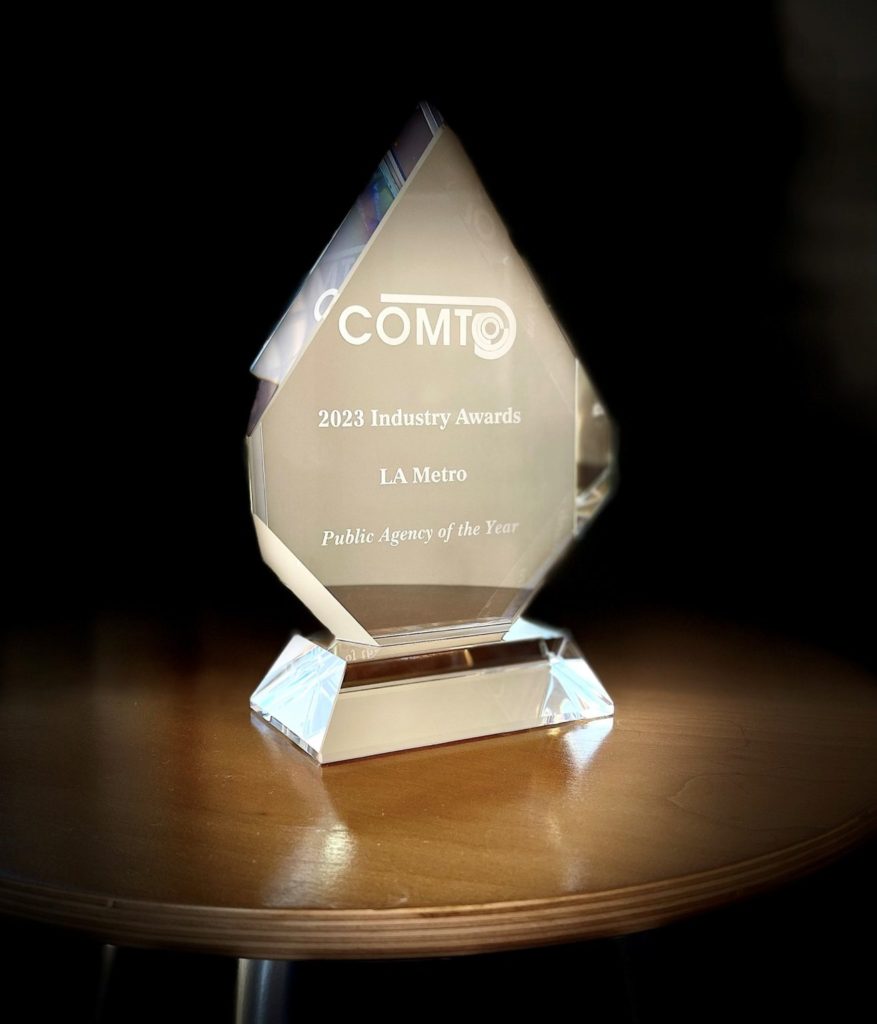
Transit Briefs: NJ Transit, Metra, MBTA, LA Metro, SMART, OC Transpo
Written by Carolina Worrell, Senior Editor
NJ Transit signs lease for new headquarters. Also, Metra launches survey for 2024 fare structure proposal; the Massachusetts Bay Transportation Authority (MBTA) eliminates significant speed restriction in Orange Line Tunnel; LA Metro launches new fare capping policy on Cubic-powered TAP system and is honored with the 2023 Conference of Minority Transportation Officials (COMTO) Agency of the Year Award; Sonoma-Marin Area Rail Transit (SMART) reduces price of 31-day pass in response to hybrid work week; and OC Transpo announces that it does not have a firm timeline for when service will resume on its LRT Confederation Line following a shut down due to a bearing issue.
NJ Transit
NJ Transit announced July 18 that it has signed a 25-year lease to “establish efficient, modern offices” in Newark’s Two Gateway Center, with a direct pedestrian connection to Newark Penn Station.
According to the agency, NJ Transit’s current headquarters at Penn Plaza East is more than 30 years old and would require approximately $120 million in repairs and renovations over the next six years, including complete overhauls and replacements to elevators and the HVAC and other systems. The repairs and reconstruction would take several years, and require temporarily relocating employees, significantly disrupting the work environment, productivity, and the efficient management of the transit system, NJ Transit said.
According to NJ Transit, the agency’s 25-year Two Gateway lease includes approximately 407,000 square feet of space in open floor plates, which will be built to suit. Two Gateway has just been newly renovated, and the lease allows the potential to expand or contract NJ Transit’s footprint as needed.

Two Gateway Center provides direct access to Newark Penn Station via the Gateway Center’s pedestrian bridge, as well as Gateway’s new street level entrance just across from the station’s historic waiting room. The Murphy Administration has committed more than $190 million to renovating and restoring Newark Penn Station to again be the “crown jewel” of the state’s transportation system, serving as a grand entryway to New Jersey.
Onyx Equities, the owner of Two Gateway, has agreed to provide $130 per square foot toward design and construction, currently valued at approximately $53 million, specifically to meet NJ Transit’s needs and “create a modern work environment, customized to maximize productivity and efficiency,” according to the agency. The new, up to date work space will also help NJ Transit attract and retain professional staff, and will allow consolidation of administrative employees from other locations throughout the state.
NJ Transit says it expects to occupy the new Two Gateway Center headquarters by the end of 2024. The disposition of the current, Penn Plaza facility is still to be determined.
“NJ Transit’s new headquarters will provide a more efficient and collaborative workspace for NJ Trandit’s employees who design, build and operate our transit system,” said New Jersey Department of Transportation (NJDOT) Commissioner and NJ Transit Board Chair Diane Gutierrez-Scaccetti.
“NJ Transit has always been committed to keeping our presence in Newark, the City which has been our home since our creation more than 40 years ago,” said NJ Transit President & CEO Kevin S. Corbett. “NJ Transit has now negotiated a lease agreement that provides the best value for New Jersey’s taxpayers, for our customers, and our employees. This new headquarters provides the modern office environment required to properly run the nation’s largest statewide transit system.”
Metra
Metra announced July 17 that it has opened a survey and scheduled informational sessions at downtown stations to solicit feedback about proposed changes to its fare structure for 2024 that would reduce the number of fare zones to four from 10 and change some of the fare options available.
Metra will also hold an online open house on July 25 from 6:30 p.m. to 7:30 p.m.
In additiona, information tables staffed by Metra workers will be set up at the following locations to provide details about the plan and answer questions:
- July 19: Millennium Station, 3 p.m. to 7 p.m.
- July 26: Chicago Union Station, 3 p.m. to 7 p.m.
- Aug. 1: LaSalle Street Station, 3 p.m. to 7 p.m.
- Aug. 2: Ogilvie Transportation Center, 3 p.m. to 7 p.m.
According to Metra, the proposal “aims to create a fare structure that customers can easily understand, that will encourage ridership, that will simplify onboard fare collection, and that meets Metra’s financial and technical constraints.” Fares would be set at or below pre-pandemic fares, and promotional fares introduced during the pandemic would be discontinued.

Currently there are 10 fare zones for One-Way and 10-Ride tickets, essentially two zones for weekday Day Passes and one zone (or, a flat rate) for Monthly Passes, Saturday or Sunday (or Holiday) Day Passes and Weekend Passes.
Under the proposal, the following changes would be implemented:
- Zones: The 10 fare zones would be discontinued and replaced with four zones (see map below) for One-Way Tickets, weekday Day Passes and Monthly Passes and one zone for all weekend passes. Downtown stations would be assigned to Zone 1 and outlying stations would be assigned to Zones 2 through 4 based on a combination of distance from downtown, service patterns and ridership characteristics on each line, which vary.
- The 10-Ride Ticket: The 10-Ride Ticket would be replaced with a new fare product, a Bundle of Five Day Passes. The bundle would be available only on the Ventra app and priced the same as the 10-Ride Ticket, at 9.5 times the cost of a One-Way Ticket. The passes in the Bundle would not have to be used on consecutive days; rather, they could be used on any five days in a 60-day period.
- Incremental Fares: “Incremental fares” – a surcharge to travel beyond the zones indicated on the ticket – would be discontinued. Riders would be required to buy a ticket valid for the trip they are taking.
The survey, which closes Aug. 6, can be found here. Full details of the plan are available here.
MBTA
The MBTA on July 18 announced the closing of the Corrective Action Plan (CAP) related to completion of repair work on a section of the Orange Line track known as the Tufts Curve located in the tunnel between Tufts Medical Center and Back Bay Stations.
The repairs were performed as part of one of the 39 CAPs that the MBTA wrote in response to the Federal Transit Administration’s (FTA) Safety Management Inspection (SMI) Report conducted in 2022. The FTA, MBTA says, officially closed the CAP in writing confirming that the agency’s repairs “appropriately addressed the track conditions.”
According to MBTA, the Tufts Curve repair work eliminates a major speed restriction along a 981-foot section of the track, northbound and southbound, allowing Orange Line trains to safely increase their operating speed to the full design speed in that section of the tunnel. Speed restrictions on the Tufts Curve were reduced to 10 mph in 2019. In the summer of 2022, the MBTA shut down the Orange Line for a 30-day period to complete critical track and signal upgrades. That work, the agency says, allowed the northbound Tufts Curve speed restriction to be raised from 10 mph to 18 mph. With the latest repairs now complete, the speed is fully restored in both directions along the curve.
The work signifies an early milestone in the MBTA’s response to the FTA’s SMI Report, the agency said. Key among the findings in the report were the significant track maintenance needs across the entire MBTA rail transit system. In these areas, trains are required to run at slower-than-normal speeds because of deficiencies caused by track wear and tear or other issues. Speed restrictions are put in place as a safety precaution to ensure rider safety.
The challenging repair work on the Tufts Curve was “complex and time-consuming” due to the geometry of the curved track and the extremely limited work windows primarily available at night, according to the agency. Work crews often faced the challenges of mobilizing and demobilizing heavy equipment, personnel, and materials within a few short hours before returning the track for the morning commute.
The completion of the Tufts Curve repair and the FTA’s CAP closure, specifically Special Directive 22-04 CAP 3, is the second CAP closure in recent months. In March of this year, the MBTA Vehicle Maintenance, with support from Quality, Compliance & Oversight, closed Special Directive 22-04 CAP 9, which restored the Green Line Work Trains and put them back into service.
“Employees and managers are committed to changing the course of the MBTA with top-to-bottom infrastructure improvements to improve safety and reliability,” said Transportation Secretary and CEO Gina Fiandaca. “We are pleased the FTA has officially closed the Corrective Action Plan pertaining to the Orange Line corridor known as the Tufts Curve and we continue to be sharply focused on repairing the remaining track issues in other rail corridors.
“Accomplishing this work was truly a team effort with contributions from many groups, including our engineers, maintenance, capital transformation, and compliance experts,” said MBTA General Manager and CEO Phillip Eng. “I thank them for their dedication and hard work to address the vital track infrastructure work. While there is still work to do across the system, the completion of the Tufts Curve section of track represents an important step towards restoring the level of service our riders deserve.”
LA Metro
LA Metro on July 1 launched a new fare capping policy using Cubic Transportation System’s (Cubic) technology.
According to Cubic, customers can now use their TAP card to pay per ride until they hit a daily fare cap of $5 or a seven-day fare cap of $18. Once the one-day and seven-day caps are reached, LA Metro riders will be able to use the system for free for the remainder of the day or seven-day period.
Prior to fare capping, riders could buy daily, weekly or monthly passes, some of which required larger purchases upfront. Now, Cubic says, these customers can load stored value (cash) onto their TAP cards or TAP mobile app and pay as they go, “lessening the economic burden of public transit usage.”
Fare capping is the latest rider benefit added to the TAP regional contactless fare system, which Cubic and LA Metro have collaborated on for more than two decades. The all-in-one system and fare-capping ability “streamlines fare payments for riders, simplifies operations for LA Metro and consolidates the number of fare products needed to create a comprehensive rider experience,” according to Cubic.
A “pioneer in enabling regional connectivity,” TAP links 26 transit agencies across the Los Angeles area and has more than 25 million active accounts across the transit network. TAP also offers an integrated mobile traveler app, which allows users to make a fare purchase or use their mobile device to complete their journey across multiple services, such as bus, rail and Metro Micro. It also provides commute information to the region’s riders.
Fare capping, Cubic says, arrives at an ideal time in Los Angeles, as the city prepares to host multiple mega events, including the 2026 FIFA World Cup and 2028 Summer Olympics—each anticipated to draw millions of global citizens. “Not only will the ability to pay contactless make the visiting rider experience easier—but fare capping will make transit the most affordable and sustainable option for attendees. This will help reduce congestion across the region during these historic, heavily attended events,” according to the company.
“Cubic’s long-standing partnership with Metro has been a collaborative effort from the very beginning, focused on bringing simpler journeys and ways to pay—as well as a better overall rider experience—to the people of Los Angeles,” said Matt Newsome, SVP and GM, Cubic Transportation Systems. “We are extremely proud to support the new fare capping initiative that will not only provide financial relief but drive equity and encourage public transportation adoption in the region. We applaud Metro for bringing this new way to pay fares to the public.”
“The fare change in support of fare capping was approved by the Metro Board of Directors last December. Now, Metro fares are simple, equitable and affordable for customers and they can earn free rides when they use their TAP card or TAP mobile app automatically,” said Metro Sr. Executive Officer David Sutton. “Through our partnership with Cubic, we are continuously improving TAP to meet the demands of LA County residents and visitors. We are also eager to see how this latest innovation will attract more customers to our transit system and incentivize our cash customers to try TAP.”
Separately, LA Metro announced July 18 that it has been honored with the 2023 COMTO Agency of the Year Award in recognition of its “achievements in expanding Los Angeles’ transit system while promoting equity and driving job growth and economic development across the region.”

According to the agency, LA Metro has “one of the nation’s most ambitious transit expansion programs underway.” In October 2022, the agency opened seven of the nine K Line stations in South Los Angeles and Inglewood. LA Metro also opened the Regional Connector in June, adding three new stations in Downtown Los Angeles and connecting the A, E and L Lines and “transforming the way people travel around the county.” These new lines make riding to and through downtown Los Angeles faster with fewer transfers—and increases access to jobs, education, essential services and arts and cultural destinations, LA Metro said.
Along with expanding LA Metro’s transit system, these projects, the agency says, have created thousands of jobs and opportunities for local businesses. LA Metro has an ambitious plan to ensure that 48% of its contracts and procurements include small, disadvantaged, and historically under-utilized businesses by 2028. This aspirational target includes the agency’s signature programs, such as the Small Business Enterprise (SBE) and Disabled Veteran Business Enterprise (DVBE), Small Business Prime (SB Prime) and the Local Small Business Preference. So far, since 2015, LA Metro has awarded more than $1 billion to small businesses across all programs.
LA Metro says it has consistently promoted diversity in the transportation industry—and the agency works to ensure that all initiatives and programs are viewed through an equity lens. LA Metro’s Equity Platform has been implemented to assist in the development of new fare policies, expansion of the transit system and streamlining the process to build new housing.
“Congratulations to CEO Stephanie Wiggins, former Board Chair Ara Najarian and the entire Metro agency for earning COMTO’s Agency of the Year Award,” said the Mayor of Los Angeles and Metro Board Chair Karen Bass. “This recognition shows that the entire organization is dedicated to expanding access to the Metro system across Los Angeles while consistently working toward a more equitable, high-quality rider experience. I thank COMTO for their partnership, for raising the importance of diversity in the transportation industry and for acknowledging Metro’s leadership this year.”
“I am so proud of the tireless efforts and dedication of our entire team in providing exceptional transportation services to our communities,” said Metro CEO Stephanie Wiggins. “We are grateful to be recognized by COMTO and inspired to continue pushing the boundaries of excellence in public transportation.”
SMART
SMART announced July 18 that, in response to a survey conducted by the Bay Area Council, which indicated that more than half of Bay Area employees are working a hybrid remote schedule, it has implemented a 15% reduction in the price of its 31-Day Pass to $117 for adults and $58.50 for youth, seniors and persons with disabilities.
Post-pandemic ridership on SMART confirms the findings of the study, the agency said. While SMART has recovered more thn 90% of its pre-pandemic ridership, the agency has seen a 50% reduction in the demand for monthly passes. The reduced 31-Day Pass pricing is based on the “new normal” hybrid work schedule of a three-day per week commute but is still valid for unlimited rides during the 31 days.
SMART’s 31-Day Pass is available with a Clipper card and can be purchased at Clipper vending machines located on all SMART train station platforms and at all North Bay transit customer service windows.
OC Transpo
Ottawa, Ontario, Canada’s OC Transpo has stated that it “does not have a firm timeline” for when it will resume full service of its LRT Confederation Line, which has been shut down since Monday due to a bearing issue, according to a CBC News report.
According to the report, “every axle on every train must now be inspected before OC Transpo can reopen the system,” said Richard Holder, Manager of Systems and Operations Integration at the City of Ottawa, at a Tuesday afternoon news conference. The full news conference is available to watch in the video below.
As of Tuesday afternoon, OC Transpo had “completed an inspection of the full length of the track and inspections of five trains in its fleet,” Holder said, according to the CBC News report.
According to the report, “the transit agency will also conduct a full test with an out-of-service ‘bogie’ train. Sensors will be used to better understand wear and tear on operating trains.”
In response to a question about heavy ridership during Bluesfest, Holder said “bogie testing will consider whether different ‘loading’ scenarios played a role in the issue, including the crowds over the past two weeks.”



